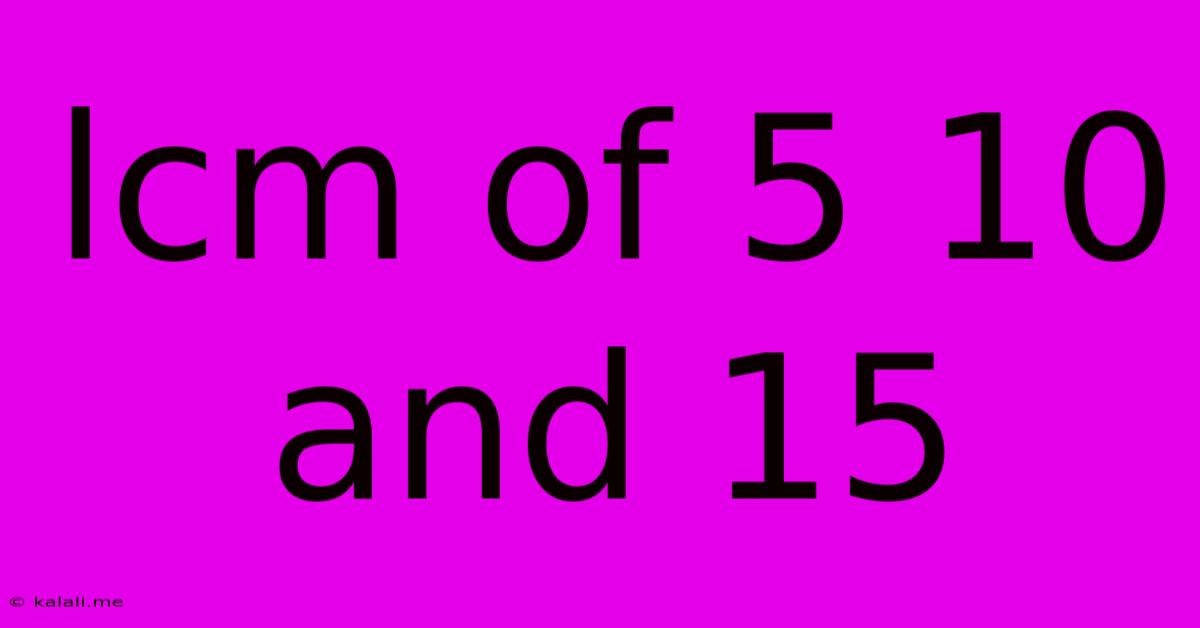Lcm Of 5 10 And 15
Kalali
Jun 15, 2025 · 3 min read

Table of Contents
Finding the Least Common Multiple (LCM) of 5, 10, and 15
This article will guide you through the process of finding the Least Common Multiple (LCM) of 5, 10, and 15. Understanding LCM is crucial in various mathematical applications, from simplifying fractions to solving problems involving cycles and timing. We'll explore different methods to calculate the LCM, making this concept accessible to everyone. This comprehensive guide will cover prime factorization, listing multiples, and using the greatest common divisor (GCD).
What is the Least Common Multiple (LCM)?
The Least Common Multiple (LCM) is the smallest positive number that is a multiple of two or more numbers. In simpler terms, it's the smallest number that all the given numbers can divide into evenly without leaving a remainder. For example, finding the LCM of 5, 10, and 15 helps determine the smallest number divisible by all three.
Method 1: Prime Factorization
This method is efficient for finding the LCM of larger numbers. It involves breaking down each number into its prime factors.
-
Find the prime factorization of each number:
- 5 = 5
- 10 = 2 x 5
- 15 = 3 x 5
-
Identify the highest power of each prime factor:
- The prime factors are 2, 3, and 5.
- The highest power of 2 is 2¹ = 2
- The highest power of 3 is 3¹ = 3
- The highest power of 5 is 5¹ = 5
-
Multiply the highest powers together:
- LCM(5, 10, 15) = 2 x 3 x 5 = 30
Therefore, the LCM of 5, 10, and 15 is 30. This means 30 is the smallest positive integer divisible by 5, 10, and 15.
Method 2: Listing Multiples
This is a simpler method for smaller numbers. It involves listing the multiples of each number until a common multiple is found.
-
List the multiples of each number:
- Multiples of 5: 5, 10, 15, 20, 25, 30, 35...
- Multiples of 10: 10, 20, 30, 40...
- Multiples of 15: 15, 30, 45...
-
Identify the smallest common multiple:
- The smallest number that appears in all three lists is 30.
Therefore, the LCM of 5, 10, and 15 is 30. This method is straightforward but can be time-consuming for larger numbers.
Method 3: Using the Greatest Common Divisor (GCD)
This method utilizes the relationship between the LCM and the Greatest Common Divisor (GCD). The formula is:
LCM(a, b, c) = (a x b x c) / GCD(a, b, c)
However, this formula is directly applicable to only two numbers, not three. To use it for three numbers, we would calculate the LCM of two numbers first, then use the resulting value with the third number.
First, let's find the GCD of 5, 10, and 15 using the prime factorization method:
- 5 = 5
- 10 = 2 x 5
- 15 = 3 x 5
The common factor is 5, so the GCD(5, 10, 15) = 5. This method, while mathematically sound, is often less intuitive for beginners than the prime factorization method when dealing with three or more numbers. It's most efficient when the GCD is already known.
Conclusion
We've explored three different methods to find the LCM of 5, 10, and 15. The prime factorization method is generally the most efficient and reliable method, especially when dealing with larger numbers or a greater number of numbers. Understanding the LCM is essential for various mathematical applications, and mastering these techniques will strengthen your mathematical skills.
Latest Posts
Latest Posts
-
What Are The Prime Factors Of 420
Jun 15, 2025
-
Countries Tropic Of Cancer Passes Through
Jun 15, 2025
-
Which Atmospheric Layer Has The Lowest Temperature
Jun 15, 2025
-
How Is Plant Cell Mitosis Different From Animal Cell Mitosis
Jun 15, 2025
-
How Many Electrons Does H Have
Jun 15, 2025
Related Post
Thank you for visiting our website which covers about Lcm Of 5 10 And 15 . We hope the information provided has been useful to you. Feel free to contact us if you have any questions or need further assistance. See you next time and don't miss to bookmark.